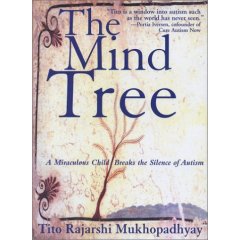
The Mind Tree

My friend Amanda sent me a copy of The Mind Tree by Tito Rajarshi Mukhopadhyay for my birthday, and I just finished it this week. Tito is a young man who has autism, a neurological disorder that causes problems with the development of communication skills and social interaction. Although his autism is quite severe, Tito has very well developed language skills and a beautiful writing style. In The Mind Tree, which was written when he was 15 years old, he tells of his despair at not being "normal." He explains with detail what it is like to be locked inside himself and unable to communicate his intentions and needs. He also explains that he spins, rocks, and flaps his arms in an effort to make himself whole. His description of how it felt to be taken from one specialist to the next, and also how it felt to be rejected by people and schools because of his disability is heart wrenching, but he also inspires hope that people with autism can be reached and taught. He went from being completely disconnected to being able to write poetry and stories that are deep and insightful. Tito wrote:
Grayish Loneliness
The colour of loneliness is gray.
When I was sitting and waiting for the cow to come and moo at the gate, as it sometimes does. I realized that I felt lonely.
The moment I realized it, things started to change their colours. Not that they did not retain their actual colours, but they became grayish.
For instance, the sun was golden but grayish. The sky was blue, but grayish. My shirt was yellow, but grayish. The tree which has the crooked smile and without any leaves, was brown, but grayish.
Anna who was talking to the postman, had some grayish coloured words for me to breathe in. When I breathed them I could feel those grayish words, flow along with my blood all over my body. I knew that my blood was red, but a little grayish.
I was in fact enjoying this grayish loneliness because gray was a soft colour. It never covered up the other colours like the devouring jaundice yellow.
It was at that moment that I realize, that the gray tasted sweet. I opened my mouth to taste the sweet gray and fill myself with its sweetness.
The cow never turned up that day although I had mooed twice. But when I mooed, I found all those words which Anna spoke, which I had pulled in started coming out with the grayish moos.
I stopped mooing, lest I lose the filling gray from myself.
(pg. 157-158, The Mind Tree)
I have worked with several consumers who had autism over the years. I wish I had known about this book when I worked with them, because I feel like Tito's explanation of how it feels to have autism allowed me to understand a little more about what my consumers were going through. That type of insight could have helped me to better meet their needs as a counselor.
His mother deserves much of the credit for his being able to function as well as he does. She worked tirelessly with him repeating tasks; moving his limbs, his hands, and his fingers to teach him how to make the motions necessary to throw a ball, write, and draw. He described how his body felt scattered, so he could not make his limbs do what he wanted until she moved them for him repeatedly. Her teaching tactics could be viewed as harsh or even abusive. Tito writes about her methods, which included tying a pencil to his hands and forcing him write, sometimes withholding food until he wrote the letters of the alphabet. He also writes with frankness of times when she struck him to get his attention. I noticed that there is at least one website on which Tito's mother is accused of abuse, but after reading the book, I don't really believe that fits her actions. She was desperate when she discovered her child had a developmental disability, but she didn't ship him off to an institution. Instead, she gave up any hopes and aspirations she may have had prior to discovering that her child was disabled, so that she could care for him and help him to reach his potential, whatever his potential may be.
According to Tito, he felt disconnected from his body and being struck made him aware of his body. I don't advocate beating disabled children, but living with people who have ADHD, another neurological disorder, has given me some insight into what works and what does not work when trying to communicate with them. I understand how sometimes touch is necessary to get their attention, so it stands to reason that the touch may need to be more forceful with people who have autism, because the disorder is more extreme. ADHD causes problems with attention, but autism causes people to "go inside themselves." They are present, but not connected to what is happening around them, so a physical approach to training may be required to get through to them when they disconnect from their surroundings.
No comments:
Post a Comment